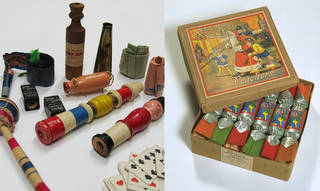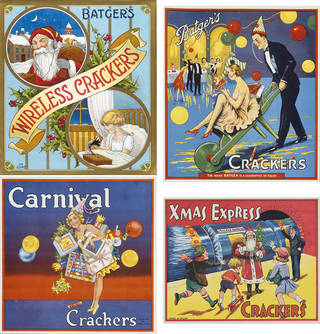Tom Smith, an enterprising baker in London's East End, invented the Christmas cracker over 150 years ago. Our collections contain some of the earliest examples of this popular paper novelty.
The Christmas cracker was invented by London-based confectioner and baker Tom Smith (1823 – 1869) who set up shop in Goswell Road, Clerkenwell in the 1840s. Smith initially produced wedding cakes and sweets. On a trip to Paris he discovered the French 'bon bon', a sugared almond wrapped in a twist of tissue paper. Bonbons proved a hit at Christmas time and to encourage year-round sales, Smith added a small love motto inside the wrapper.
The inspiration to add the explosive 'pop' was supposedly sparked by the crackling sound of a log fire. Smith patented his first cracker device in 1847 and perfected the mechanism in the 1860s. It used two narrow strips of paper layered together, with silver fulminate painted on one side and an abrasive surface on the other – when pulled, friction created a small explosion. To stave off competition, the company introduced a range of cracker designs, which were marketed as a novelty for use at a wide range of celebrations. Tom’s son, Walter, added the elaborate hats, made of fancy paper, and sourced novelties and gifts from Europe, America and Japan. The success of the cracker enabled the business to grow and move to larger premises in Finsbury Square, employing 2,000 people by the 1890s, including many female workers.

Crackers and paper hats were made by hand, which involved cutting tissue paper with heavy guillotines, pasting, folding and carefully packing for a perfect presentation. This short film from 1910 shows 'Lion Head Brand' crackers being manufactured in an Edwardian factory.
Novelty crackers followed topical trends – writers were commissioned to compose snappy lines, and the artwork for cracker boxes referenced popular crazes, from jazz to Tutankhamun, new-fangled motorcars, Charlie Chaplin and the wireless. Crackers were used to celebrate major occasions, including the end of the First World War in 1918 and the 1926 World Tour by Prince Edward, the Prince of Wales. The illustrated Tom Smith catalogues, preserved in the V&A's Archive of Art and Design, date back to 1877, providing an unusual visual record of social and political events in British history, and an insight into the changing styles of commercial design.

The brightly coloured cracker boxes were collected and traded in their own right. Batger and Company, an 18th-century sugar refiner which had branched into confectionery and novelties following Smith's success, became well known for its cracker labels. A collection of these designs can be viewed by appointment in our Prints and Drawings Study Room
The Totem Cracker
By the 1920s, Tom Smith's crackers were advertised as "World Renowned Christmas Crackers. No party complete without them". One eye-catching example in our collection is the Totem Cracker, made in 1927 by Tom Smith & Company and originally sold in boxes of 12 – in crimson, green and gold. Their name refers to a spectacular dance number, the 'Totem Tom-Tom', from the musical Rose-Marie, which opened at London's Drury Lane Theatre in 1925 and was a West End hit. Set in the Canadian Rockies, it featured a chorus of over 50 'Redskin Totem-Pole Girls', clad in colourful outfits and elaborate headdresses resembling carved animal heads.

The Totem Crackers embodied the decadent frivolity of the flapper-era musical. Combining orange cellophane over gold foil with a central sticker depicting the Totem-Pole Girl, they came complete with Totem-Pole Girl headdresses, musical toys, imitation jewellery and 'quips and jokes', and were sold for 34 shillings. Paper patterns inspired by the dancers' costumes decorate the ends, with fringed gold paper and the maker’s name finishing off the ensemble.

The Second World War caused paper rationing and a restriction on the manufacture of cracker snaps, but the industry recovered – in the 1950s and 1960s, Tom Smith & Co. was making 30,000 crackers a week. Today Christmas crackers are produced for every pocket, from luxurious to fun-sized. And the Tom Smith brand continues to produce luxury crackers, including special crackers for the Royal Household, although the designs and contents are a closely guarded secret.
Find out more about Victorian Christmas traditions

